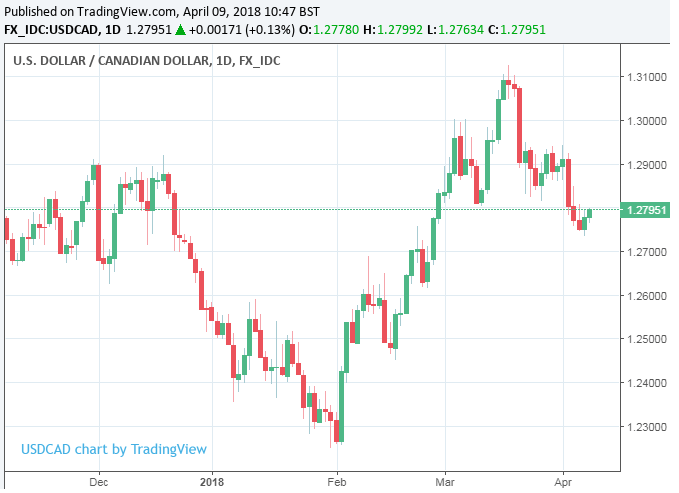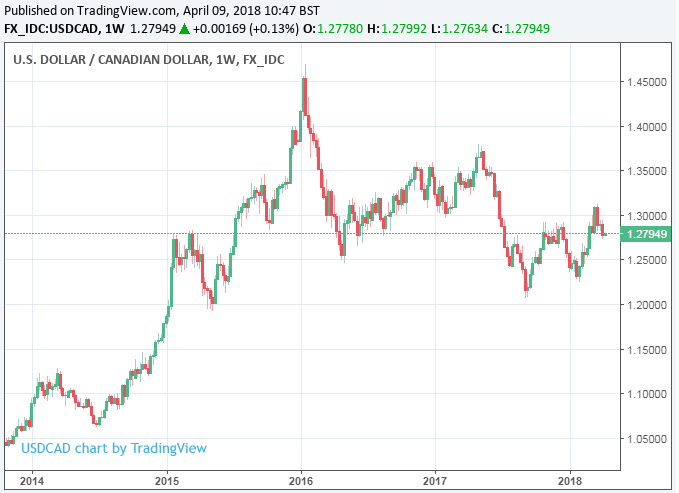Buy the Canadian Dollar and Sell the US Dollar say CIBC as NAFTA Hopes Rise
- Written by: James Skinner
-
-NAFTA renegotiation a "significant, positive shock" for the CAD
-Macroeconomic and seasonal trends call for a USDCAD fall.
-Two of Canada's largest banks eye 2.5% USDCAD downside.

© moonrise, Adobe Stock
The Canadian Dollar could be about to stage a comeback against the US Dollar, according to strategists at two of Canada’s largest banks, as pessimism toward the economy has likely reached its peak and hopes of a succesful renegotiation of the North American Free Trade Agreement are mounting.
Negotiators from Canada and Mexico made a series of encouraging noises last week as meetings in Washington drew to a close. This was amid speculation the White House is pushing for an “agreement in principle” that can be unveiled at the Summit of the Americas that kicks off in Peru on Friday 13, April.
A New York Times report Friday claimed Mexican economy ministers are “very convinced” a deal to save the NAFTA pact can be reached soon while US Treasury Secretary Steven Mnuchin also told reporters negotiators are making “good progress” Friday. Canada’s Foreign Minister, Chrystia Freeland, was more coy when she told the media ““We have always said we’re going to take the time it takes to get a good deal.”
Comments Friday have contributed to a further easing of tensions over the fate of the North American Free Trade Agreement, which is important to the Canadian and Mexican economies but could be torn up by President Donald Trump if new terms that satisfy several US concerns with the deal cannot be agreed.
Analysts have previously estimated that a NAFTA withdrawal by the US could see the Canadian Dollar fall by as much as 20% and they may not have been wrong either, considering the Loonie dropped more than 2% against an already-weak US Dollar in February and March when concerns about whether a deal could ever be struck first began to emerge.

Above: USD/CAD shown at daily intervals. Captures February and March CAD weakness.
“Our base case forecast incorporates a positive outcome in NAFTA renegotiations but we had expected talks to drag out. Now, however, risks seem to be shifting towards a deal in principle sooner, rather than later. Considering that many market participants considered NAFTA to be dead on its feet just a matter of weeks ago, any clear progress on this front in the next few weeks would represent a significant, positive shock for the CAD, we feel,” says Shaun Osborne, chief FX strategist at Scotiabank.
This follows two weeks where markets had become less concerned about the deal following a Globe and Mail report suggesting the White House has abandoned a key but highly contentious demand that any cars shipped across Mexican and Canadian borders, into the US, contain a much higher level of US made parts than has been the case in recent years. Although NAFTA related optimism is not the only factor that could drive the Canadian Dollar higher in April.
“There are a few compelling reasons to like the CAD tactically this month. Seasonal pressures driven by movements in the crude markets ahead of the summer is one. So too is the improved tone surrounding NAFTA negotiations which have reduced the premium attached to trade in price action for the loonie,” says Bipan Rai, a macro strategist at CIBC Capital Markets.
CIBC’s Rai and Scotiabank’s Osborne are both looking at the Canadian Dollar as a likely candidate for a rebound this month. Hopes around a NAFTA deal feature prominently in their rationales but so too do seasonal patterns in international money flows and oil markets, as well as Canadian macroeconomic fundamentals.
“CAD seasonal patterns typically mirror those observed in crude and we are entering a period of the year in which CAD tends to strengthen vs. the USD. Although we acknowledge the recent breakdown in the CAD/crude correlation, it has recovered from its recent lows (-33% in January) and is currently sitting just below 50% (on a rolling, 22-day basis),” says Osborne.

Above: USD/CAD shown at weekly intervals. Captures longer term trend.
Canadian economic momentum has slowed in the New Year. The best illustration of this is the January GDP print, which came in at -0.1%, marking the second monthly contraction since the Bank of Canada began raising interest rates last July.
This led markets to conclude that first quarter economic growth will be slower than that seen last year and beneath the Bank of Canada forecast for an annualised expansion of 2.5%, which is a negative for currency-watchers who are hoping the central bank will raise interest rates again any time soon. Nonetheless, both Rai and Osborne are watching for a turn in the economic surprise index and have suggested it could be act as a catalyst for a turnaround in the Canadian Dollar.
“An equally compelling argument is the adjustment of market expectations when it comes to economic data. A useful tool for this is the economic surprise index (or ESI). The gauge is below the -50 mark indicating that market expectations for Canadian data is already low,” says CIBC’s Rai. “During periods in which the index is below -50, the [USDCAD] correlation breaks down as the regime is more likely to change. In the present case, the regime is likely to switch to upward surprise in domestic economic data rather than disappointment. That points to USD/CAD downside in the weeks to come.”
Rai flags that the Economic Surprise Index has spent an average of 12 days below the -50 mark on each dip beneath it since 2010 and, so far, the index has already spent six days beneath the threshold in the latest period. Rai and the CIBC team advocate using the current period of pessimism toward Canada’s economy as an opportunity to position for an anticipated rebound in sentiment, macroeconomic indicators and the Canadian Dollar. Scotiabank’s Osborne appears to be thinking along the same lines.
“We have yet to see any real improvement in the relative tone of US-Canada economic data to support a recovery in the CAD but we still think this will emerge and the window for a bounce in the CAD remains wide open, in our opinion in any case,” Osborne writes, in a recent note.
Osborne and the Scotiabank team are looking for the USDCAD rate to move lower toward the 1.25 threshold over coming weeks as the Loonie draws support from rising oil prices while macroeconomic data and NAFTA headlines become more supportive. Meanwhile, the strategy team at CIBC are advocating that clients actively bet on such a move.
“We’re entering into a tactical short position for USD/CAD at spot (currently 1.2775) and targeting a move to the 1.2485 mark with a stop at 1.2885,” Rai writes in a note Monday.
The USD/CAD rate was quoted 0.09% higher at 1.2791 during the morning session in London Monday while the Pound-to-Canadian-Dollar rate was 0.30% higher at 1.8046.
Advertisement
Get up to 5% more foreign exchange by using a specialist provider to get closer to the real market rate and avoid the gaping spreads charged by your bank when providing currency. Learn more here.





